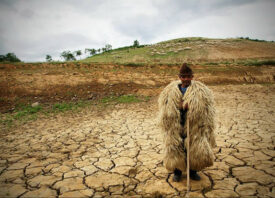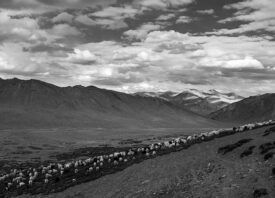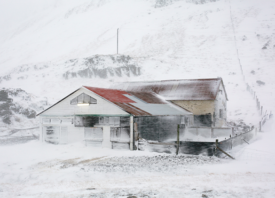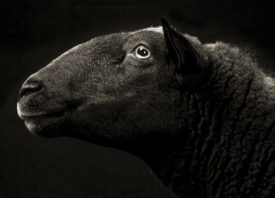Search this site
Illustrating Faith, Grief, and Healing In Richly Symbolic Photographs



“The moment I walked into that house, I knew it was the one,” the artist Jennifer Thoreson remembers. “I had chills.” She’d searched for a long time to find a house in New Mexico that resembled her childhood home in rural Texas. “I made a few snapshots that day, and I still think of those images as whispers—the way the light played on the walls and floors, lovely shifts in colors, rays of sunlight streaming through dust in the air kicked up by my own motion,” she tells me. She rented the house and worked there for a year, creating the sculptures, photographs, and installations that would later become Testament.
Thoreson grew up in a Southern Baptist household, and she was encouraged from an early age to express herself through the creation of art. “Dad still teaches adult Sunday school and is the director of music at their church,” the artist says. “Our faith was the root and center of our home; everything revolved around it.” The stories she learned as a child remained with her into adulthood, continuously helping to inform her work.
“I’ve always been a bit of a melancholy sort and empathetic to a fault,” Thoreson admits. “I always dwelled on the suffering of the people in Bible stories; I still do. As a kid, it is a big emotional undertaking to imagine myself in the shoes of Abraham standing in front of an altar, preparing to burn his son alive, or as one of the many kids who drown in the great flood, or as a man thrown into a den full of hungry lions.
“But I also thought a lot about what it would’ve been like to be the recipient of a healing miracle, or to walk on the floor of the Red Sea between two enormous walls of water. I think the one I dwelled on most as a kid, and still do today, is the Christmas Story, the birth of Jesus—especially the role of Mary. I still can’t work out all the emotional complexity of it. I love the stories still because they’re so fraught and heavy with humanity.”
While creating the sculptures to be installed inside the rental house, Thoreson incorporated materials that appear time and again throughout those stories: clay to represent humanity, molded by the hand of God; latex rubber to stand in for human flesh; and human hair and wool to represent the sheep of His flock. These sculptures started life in her studio before transitioning into the house, where they were joined by objects from the artist’s childhood.
“I spent a lot of time digging into childhood photo albums, identifying special objects or textiles, and exhaustively searching in resale shops for identical matches,” she remembers. “The satisfaction of finding the objects was so fulfilling. It lent a real warmth to the house; I loved spending time there.
“Every object you see in the work has a memory associated with it. I was able to find the exact linens that were on my bed as a girl, the same bowl of wooden fruit I used to play with and roll around in my hands over and over as a kid—I loved how smooth they were. Everything–from the dishes, the food, electronics, curtains, even medications and book titles–is tied to my childhood home.”
And then there were the people who brought the pictures to life. “The models are mostly people I know, as I felt I needed a certain amount of trust and vulnerability to produce these interactions,” Thoreson says. “For Family Portrait, my own family drove to New Mexico from Texas to participate in the work, which meant a great deal to me.”
Although the artist herself doesn’t appear in any of the photographs, she does think of some of them, at least in part, as self-portraits because they represent her experiences. The process of creating and photographing the sculptures was precise and labor-intensive but also represented a kind of release. “The series is an illustration of the guilt I feel about wrestling with anxiety, and how that relates especially to my childhood understanding of faith,” the artist explains.
“There are many verses in the Bible that address anxiety and troubled hearts, particularly a passage in 1 Peter, which reads: ‘Humble yourselves, therefore, under God’s mighty hand, so that in due time He may exalt you. Cast all your anxiety on Him, because he cares for you.’ As a kid, I’d hear these ideas in Sunday School, then return to a nightly four-step ritual I’d developed for telling my parents good-night, as I was deeply afraid they’d pass away or disappear while I slept.
“I’d love to say my anxiety has gotten better over time, but after becoming the mother of two precious boys—it’s multiplied. I think making the work did help, it was an act of catharsis to fabricate the sculptures and installation pieces, using my hands to produce tangible representations of the burden of anxiety. Moreover, I’ve been astonished by the number of people who identify so closely with the work, and can place themselves in the photographs, bearing weight. While the anxiety isn’t any better, I feel a lot less alone.”
In one of the photographs, Father, Daughter, Thoreson’s pastor and friend appears with his child. “He sat on the end of the bed, and we attached the sculpture to his back, piece by piece,” she recalls. “Each of the pieces was a stretched nylon filled with wool, dipped in wax—they were quite rigid and very heavy. While there was some discomfort in taking on the weight, it was bearable, as it was applied bit by bit.
“When we finished the photograph, he stood up slowly, and all of the weight fell away at once. He said in that moment he’d never seen a more beautiful illustration of the process of enduring pain—it is built up and made heavier over time, and often the person under the weight has no real perception of the amount they are carrying. We both stood silent for a while, absorbing that—it was an important experience that has had a real impact on my practice.”
The materials she used for the sculptures were repurposed for an exhibition, which took place inside the rental house. She used the fleeces from Soulmates to create a sculpture of a pregnant woman; in the exhibition, that woman was then placed upon a blanket made from the materials used in Hair Cloak. She spun yarn from the red wool in Cancer and used it to create a hand-woven rug and two pairs of hands, meant to represent the human body. The act of repurposing spoke to the larger idea of rebirth and redemption.
After the year was done, Thoreson had to say goodbye to that house–a place that had become a surrogate for her childhood home–and move on to someplace new. But she did leave a piece of herself behind. “I wanted a space that was like a sanctuary—wholly dedicated to the work for a period of time,” she tells me. “It was like entering into a relationship with a place. We gave each other our all. We restored a lot of the features and re-painted the entire house before leaving—and I buried a time capsule in the walls, filled with a bit of the material from every sculpture that was installed there.”

human body, death, and resurrection. I was particularly interested in using clay as a material, to reference Isaiah 64:8 in the Bible: But now, O LORD, thou art our father; we are the clay, and thou our potter; and we all are the work of thy hand.”

that weight was lifted all at once, the sense of immediate relief was astonishing.”





Jennifer Thoreson is a winner of Feature Shoot’s Reader Submission Spotlight. Every month, we invite photographers to submit their best bodies of work, with three chosen to be featured on our website and in both our regular and special edition newsletters, going out to an estimated 80,000 people overall, including gallerists, publishers, editors, agents, and more. You can submit your work for consideration here.
All images and captions © Jennifer Thoreson
Read this next: Picture Anxiety Through the Lens of Five Photographers



